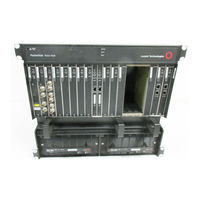Lucent Technologies PacketStar PSAX 20 Manuals
Manuals and User Guides for Lucent Technologies PacketStar PSAX 20. We have 4 Lucent Technologies PacketStar PSAX 20 manuals available for free PDF download: User Manual
Lucent Technologies PacketStar PSAX 20 User Manual (644 pages)
1-Port Channelized STS-1e, T1 Format Module
Brand: Lucent Technologies
|
Category: Gateway
|
Size: 4 MB
Table of Contents
-
-
-
History20
-
-
-
-
-
-
-
-
-
Primary Page389
-
Statistics Page393
-
Backup Page395
-
Utilization Page397
-
-
Primary Page406
-
Statistics Page407
-
Utilization Page412
-
Primary Page418
-
Statistics Page419
-
Utilization Page421
-
Primary Page429
-
Statistics Page430
-
Backup Page433
-
Utilization Page435
-
Primary Page443
-
Statistics Page443
-
Utilization Page446
-
Primary Page456
-
Backup Page457
-
Primary Page466
-
Statistics Page467
-
Backup Page470
-
Utilization Page473
-
Primary Page480
-
Statistics Page481
-
Utilization Page482
-
-
Primary Page487
-
Statistics Page491
-
Utilization Page493
-
Menu Options497
-
-
Primary Page509
-
Statistics Page511
-
Utilization Page513
-
Primary Page522
-
Statistics Page523
-
Utilization Page527
-
Primary Page535
-
Statistics Page536
-
Utilization Page539
-
-
Glossary
583
Advertisement
Lucent Technologies PacketStar PSAX 20 User Manual (596 pages)
PSAX 6-Port DS1 IMA Module
Brand: Lucent Technologies
|
Category: Gateway
|
Size: 4 MB
Table of Contents
-
-
-
-
History22
-
-
-
-
-
-
-
System307
-
-
-
Primary Page366
-
Statistics Page367
-
Backup Page370
-
Utilization Page373
-
-
Primary Page379
-
Statistics Page380
-
Backup Page383
-
Utilization Page386
-
-
Primary Page393
-
Statistics Page394
-
Backup Page397
-
Utilization Page399
-
-
Primary Page409
-
Backup Page410
-
Backup Page423
-
Utilization Page426
-
-
-
-
Primary Page487
-
Statistics Page488
-
Utilization Page491
-
-
-
Glossary
535
Lucent Technologies PacketStar PSAX 20 User Manual (268 pages)
4-Port Voice 2-Wire Office Module for the PacketStar PSAX Multiservice Media Gateways
Brand: Lucent Technologies
|
Category: Telephone Accessories
|
Size: 1 MB
Table of Contents
Advertisement
Lucent Technologies PacketStar PSAX 20 User Manual (400 pages)
Access Concentrator
Brand: Lucent Technologies
|
Category: Network Hardware
|
Size: 2 MB
Advertisement
Related Products
- Lucent Technologies PacketStar PSAX 1250
- Lucent Technologies PacketStar PSAX 1000
- Lucent Technologies PacketStar PSAX 4500
- Lucent Technologies PacketStar PSAX 2300
- Lucent Technologies PacketStar PSAX 60
- Lucent Technologies Cajun P550 Guide
- Lucent Technologies Cajun P118SX
- Lucent Technologies PortMaster OR-U
- Lucent Technologies PARTNER-6
- Lucent Technologies PortMaster PM-2ER



